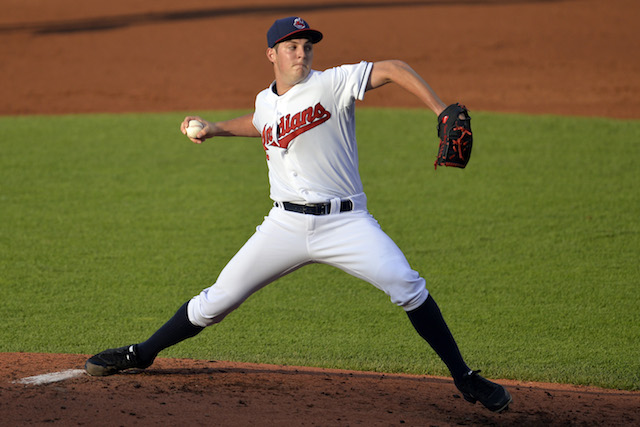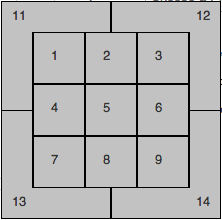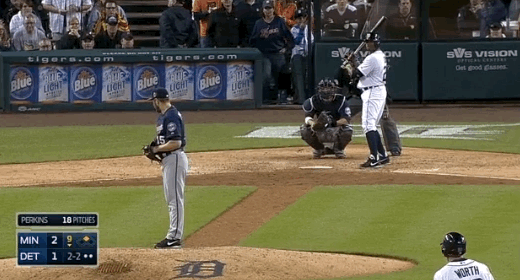
More MLB: Power Rankings | Expert Picks | Latest news & notes | Fantasy news
These days, the sinker, or two-seamer, is ascendant. More pitchers throw it, and the pitchers who do throw it tend to throw it more often. Maybe the unassailable success and lasting footprints of Dave Duncan are at work, but for whatever reason most teams are focused on developing pitchers who can keep the ball on the ground. That's sensible, of course, as groundballs tend to be less damaging than those hit in the air.
There are, however, those who stand bravely athwart those larger trends, and this post is about them. Thanks to the wondrous and essential Baseball Savant, we're able to highlight pitches that are up and in and the pitchers who, um, pitch them.
So we're including all pitchers who have thrown at least 500 total pitches in 2014, and we're using the following Baseball Savant pitch grid ...

What you see above is from the catcher's point of view, so when we're sorting for right-handed opposing hitters, we're interested in sectors 1 and 11 (11 includes a little middle-in and middle-up territory, but it's good for our approximate purposes). Likewise, when we're looking at left-handed opposing batsmen, sectors 3 and 12 will be relevant.
Now let's look at those pitchers who, against RHBs in 2014, have thrown the highest percentage of their pitches up and in (i.e., again, in sectors 1 or 11) ...
| Rank | "Up and in" pitches | Name | Total pitches | Percent "up and in" |
|---|---|---|---|---|
| 1 | 90 | Glen Perkins | 516 | 17.44% |
| 2 | 140 | Trevor Bauer | 810 | 17.28% |
| 3 | 95 | Tommy Kahnle | 582 | 16.32% |
| 4 | 153 | Tony Cingrani | 1112 | 13.76% |
| 5 | 71 | Brian Schlitter | 519 | 13.68% |
| 6 | 66 | Tyler Thornburg | 511 | 12.92% |
| 7 | 72 | Tony Watson | 565 | 12.74% |
| 8 | 77 | Daniel Webb | 612 | 12.58% |
| 9 | 205 | Madison Bumgarner | 1644 | 12.47% |
| 10 | 65 | Adam Ottavino | 530 | 12.26% |
What you see above is sorted by high-and-inside pitches as a percentage of total pitches. As you can see, Twins closer Glen Perkins leads all comers in this regard. That's interesting because Perkins, as a left-handed closer, obviously isn't a reliever who's shielded from the opposite side (in fact, right-handers make up more than 75 percent of his batters faced this season). Pitching inside against an opposite-handed hitter is often challenging because the path of the ball can take it through the hitting zone. Perkins, though, isn't daunted, as the above numbers demonstrate. Let is also be said that Perkins is a very good, very heady pitcher.
Now let's take a look at those most willing to pitch up and in against left-handed batters ...
| Rank | "Up and in" pitches | Name | Total pitches | Percent "up and in" |
|---|---|---|---|---|
| 1 | 58 | Aaron Loup | 564 | 10.28% |
| 2 | 173 | Justin Verlander | 1774 | 9.75% |
| 3 | 76 | Trevor Bauer | 810 | 9.38% |
| 4 | 58 | Nick Tepesch | 642 | 9.03% |
| 5 | 117 | Jordan Zimmermann | 1344 | 8.71% |
| 6 | 149 | Johnny Cueto | 1743 | 8.55% |
| 7 | 130 | A.J. Burnett | 1657 | 7.85% |
| 8 | 39 | Fernando Rodney | 513 | 7.60% |
| 9 | 42 | Rex Brothers | 560 | 7.50% |
| 10 | 38 | Sean Doolittle | 508 | 7.48% |
Interestingly, we see a handful of current and recent frontline starters -- Verlander, Zimmermann, Cueto, Burnett -- who semi-regularly pitch up and in to lefties.
Broadly, we think of up-and-in offerings as purpose pitches designed to make the batter uncomfortable or, in stronger terms, "send a message." That's part of it, to be sure -- reclaiming the inner third and all that. Beyond that, though, it's also about placing the ball where it's hard to hit. That sounds obvious, of course, but this is an under-utilized part of the zone when it comes to missing bats and inducing weak contact.
In a related matter, we see the name Trevor Bauer on each of these lists. That is, Bauer works up and in regardless of batter handedness. This isn't particularly surprising, given that Bauer is a bit of evangelist for the "Effective Velocity" (EV) pitching school of thought. (Aside: Jason Turbow of SBN recently wrote a lengthy and excellent examination of the EV movement; do yourself a favor and read it.)
It's a fairly involved theory, but, in rough terms, the idea is that up-and-in pitches seem a good deal faster to hitters than radar-gun readings would lead you to believe -- up to 5.0 mph faster. That's because when the pitch is up and in and a hitter offers at it, he has less time to get his hands -- and the barrel -- in hitting position than he would with a pitch, say, low and outside.
Let Mr. Perkins demonstrate ...

That's why Bauer, for instance, even in the age of the sinker, is so willing to pitch high and tight. You can't do it all the time, obviously, as you need to mix up pitches (if for no other reason than purposes of "game theory"), but a willingness to pitch to in at a hitter's elbows or even shoulders has advantages beyond just making him less comfortable in the box.
No doubt, there are some missed spots in the numbers above (i.e., the pitcher meant to locate somewhere else but wound up high and tight), as are some "pitches of reproach" designed to express disapproval toward a hitter who ran afoul of something or other. There are also, as mentioned, hight-and-tight pitches that are "real estate transactions" -- clearing the way for front-door breaking balls or inside fastballs on the black. Others, though, wind up there because pitchers like Perkins and Bauer know such spots are at once tempting and nigh impossible for the hitter.
You see, not everyone is keeping the ball down these days.
(To repeat: You need to read "The Essence of Velocity" by Jason Turbow)





















